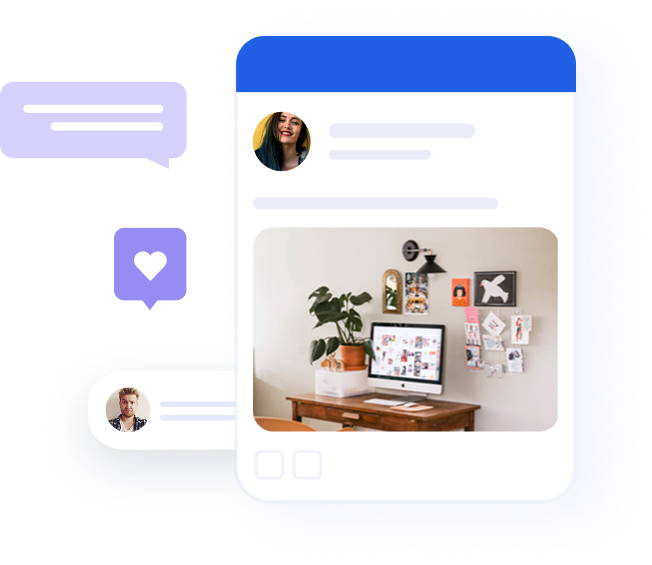Build your voice and network: A guide to writing great social media posts

Table of contents
- 1. Why your voice matters
- 2. How being active on social media helps your career
- 3. General tips for writing great social posts
- 4. How to write for each platform
- 5. What to say: common post types and how to write them
- 6. Post examples by platform and type
- 7. How AI can support your social writing
- 8. Final encouragement
- 9. Try your first post this week
- An AI prompt bank for writing social Media posts
- How to use these prompts:
- Bonus: Style rewrites & tone adjustment
1. Why your voice matters
Social media is where business conversations happen. But here’s what makes them work: authenticity. That’s why your posts, when they come from your own experience and voice, carry far more influence than official brand messaging.
Even in employee advocacy programs, the most effective voices aren’t polished marketers; they’re real professionals sharing honest experiences.
When you post, you represent yourself first. And that’s exactly why it resonates.
2. How being active on social media helps your career
Professionals who actively contribute on social platforms build long-term career capital. Here’s how:
🔹 You build thought leadership
Consistently posting thoughtful content creates visibility and positions you as a go-to expert.
🔹 You expand your network
Every post is a chance to connect with customers, industry peers, or mentors, many of whom you may never meet otherwise.
🔹 You stay top-of-mind
Being active online keeps you visible inside and outside your organization. That visibility opens doors.
🔹 You clarify your expertise
Posting helps you refine your ideas, communicate more clearly, and build confidence in your professional voice.
According to LinkedIn’s employee advocacy research, employees typically have 10x more followers than the brand they work for.
LinkedIn data has shown that content shared by employees receives up to 8x more engagement than content shared by corporate channels.
Recommended for further reading
3. General tips for writing great social posts
Before getting into platforms and formats, some universal rules apply:
- Lead with value: What’s the takeaway, insight, or benefit to your audience?
- Be concise, but specific: General ideas don’t engage, specific stories do.
- Use your own tone: Write as you’d speak to a peer or colleague.
- Add media: Posts with visuals (photos, charts, videos) tend to receive more engagement.
- Include this structure: Use spacing, line breaks, or emojis for easy readability.
Example: General employee posts on LinkedIn
Below are a few favorite examples from people I follow
Kevin Lau, the VP of Customer Engagement at Freshworks
Graeme Ventris, VP EMEA, WalkMe
And an example of a post from a planning session
Just wrapped up a cross-functional project with Product and CS teams, and I’ve learned three things about listening before leading.
- You can’t solve what you don’t understand.
- Speed matters, but empathy matters more.
- The best insights come from unexpected voices.
Grateful to be part of a team that pushes me to grow.
4. How to write for each platform
Here’s how to match your message to the platform’s best practices.
Table 1: Platform quick reference guide
|
Platform |
Best for | Tone | Ideal length | Visuals needed |
|
|
Thought leadership, insights | Professional, warm |
150–300 words |
Optional but helpful |
| X (Twitter) | Fast takes, commentary | Concise, clever |
1–2 sentences |
Optional |
| DEI, culture, and celebrations | Human, inspirational |
50–100 words |
Required | |
| Announcements, milestones | Casual, friendly |
100–150 words |
Preferred | |
| Advice, work lessons | Honest, informal |
200–300 words |
Not required | |
| Quora | Professional Q&A, deep dives | Thoughtful, helpful |
200–400 words |
Not required |
5. What to say: common post types and how to write them
Table 2: Content-type writing guide
|
Post type |
Best platforms | Writing tip |
Example idea |
| Product updates | LinkedIn, X | Focus on why it matters | “This feature helped us solve…” |
| Thought leadership | LinkedIn, Quora | Share what you’re learning | “I used to think X. Now I’ve learned Y.” |
| Company news | LinkedIn, Facebook | Make it people-first | “Proud to be part of…” |
| DEI / Pride stories | Instagram, LinkedIn | Speak personally and inclusively | “Pride Month reminds me why inclusion…” |
| Industry insights | LinkedIn, X | Lead with a stat or strong POV | “73% of buyers trust employees over brands…” |
| Personal experiences | Reddit, LinkedIn | Be honest and reflective | “A tough project taught me…” |
| In-person conferences & events | LinkedIn, X, Instagram | Tell everyone you will be there! Suggest meeting up |
Have you registered for MWC in Barcelona? I plan to be there; I would love to meet up. |
Tom Kerr, Sales Manager, Oktopost
6. Post examples by platform and type
Thought leadership – LinkedIn
Last year, I struggled to say no to a lengthy list of ambiguous client expectations.
This year, I’ve learned how to align expectations early, and everyone is happier.
Here’s what changed:
✅ We walked through success metrics upfront
✅ I asked ‘What does success look like?’ before proposing solutions
✅ I looped in CS early when the upsell potential shows up
Growing in this area has made me a better partner and colleague.
Product win – X (Twitter)
Just launched a new customer feedback loop with Product. We closed the feedback-action loop in <30 days. That’s customer obsession in action.
#CustomerExperience #ProductOps
🏳️🌈 DEI / Pride – Instagram
Pride Month isn’t just a moment—it’s a movement.
Today, I’m reflecting on the mentors who created space for me to show up authentically.
🏳️🌈 Inclusion isn’t extra. It’s essential.
#Pride2025 #InclusionAtWork #OktopostLife*
Lesson learned – Reddit
I spent the first 5 years of my career trying to speak more in meetings.
It turns out that my real growth came from listening better.
These days, I take 3–5 minutes before every important call to center around:
- My intention
- Who do I need to hear from?
- What might go unsaid
Curious—what small habits have changed how you lead?
Pro tip: Don’t post and ghost. If you ask for comments by asking a question, be sure to respond to those comments and thank people for answering.
7. How AI can support your social writing
If you’re new to writing social posts or short on time, AI can be a helpful partner in the process:
What AI can help you with:
- Brainstorming hooks: Give it your topic or takeaway, and it can generate 3–5 post openers.
- Rewriting for tone: Want it more casual? More polished? AI can adjust the voice to suit LinkedIn vs Reddit.
- Shortening long thoughts: AI can distill an internal email or learning into a 2-sentence insight.
- Creating post variations: Need to post on LinkedIn and X? AI can adapt your content for both platforms.
Pro tip: Always review AI-generated content for tone, accuracy, and authenticity. Let it support your voice, not replace it.
8. Final encouragement
Your social media presence doesn’t need to be perfect; it just needs to be real. By showing up, sharing lessons, and celebrating wins (big or small), you build trust and influence with your audience.
Start with one post. One story. One insight.
You don’t need a following to make an impact. You just need a voice and the courage to use it.
Pro Tip: Even before you start posting your own posts, go into your feed (on LinkedIn, X, Facebook, or Instagram and respond to other people’s posts. Tell them what you think, answer their questions, and respond to their thoughts. It is an easy way to get started. It’s learning how to interact on social and carry on a conversation.
9. Try your first post this week
Here’s your checklist:
- Pick a format from this guide
- Write a quick draft (or ask AI to help)
- Tag a teammate or add a visual
- Post it on your preferred platform.
- Let your advocacy manager know—they’ll love it!
Still unsure? Reach out to your social team. They are there to help you grow.
An AI prompt bank for writing social Media posts
How to use these prompts:
- Copy and paste the prompt into your AI tool of choice.
- Add context (replace anything in brackets).
- Edit the output for tone, authenticity, and accuracy.
- Publish it on your platform of choice!
Thought leadership prompts
Prompt 1:
Write a LinkedIn post that reflects on a recent challenge I faced as a [job title]. The challenge was [describe the challenge], and I learned [key takeaway].
Prompt 2:
Draft a professional post about something I’ve changed my mind about in my field. I used to think [X], but I now believe [Y]. Help me make this reflective and insightful.
Prompt 3:
Help me turn this customer conversation into a social post: “[Insert snippet of customer insight or comment].”
Product or work win prompts
Prompt 4:
Turn this product launch/update into a short, engaging post: “[Insert product or feature name] solves [problem] by [solution].” Keep it professional and concise for LinkedIn.
Prompt 5:
Write a tweet about a recent success we had using our product. The outcome was [describe], and the team effort involved [highlight collaboration]. Make it energetic and use 1–2 hashtags.
🌈 Culture, DEI, and Pride prompts
Prompt 6:
Write an Instagram caption about what Pride Month means to me at work. I want to highlight [personal story or reflection] and encourage inclusivity.
Prompt 7:
Help me write a short post about what it feels like to be part of a diverse and inclusive team. Keep it authentic and uplifting.
Research or industry insights prompts
Prompt 8:
Write a LinkedIn post using this stat: “[Insert industry stat].” Tie it to how it impacts [my role/company/customers]. End with a question to invite engagement.
Prompt 9:
Turn this blog summary into a 3-line social post that explains one key insight and why it matters: “[Paste paragraph or key idea from blog].”
Personal growth and lessons learned.
Prompt 10:
Help me write a social post about a time I failed or made a mistake and what I learned from it. The mistake was [describe briefly], and my main takeaway was [lesson]. Make it human and reflective.
Prompt 11:
Turn this journaling note into a social post: “[Paste note].” Make it sound natural, thoughtful, and relevant to my work as a [job title].
Bonus: Style rewrites & tone adjustment
Prompt 12:
Rewrite this post to sound more professional but still personal: “[Paste post]”
Prompt 13:
Make this LinkedIn post sound more concise and polished: “[Paste draft]”
Prompt 14:
Turn this long internal update into a short, engaging social post. Focus on the main takeaway: “[Paste update]”



